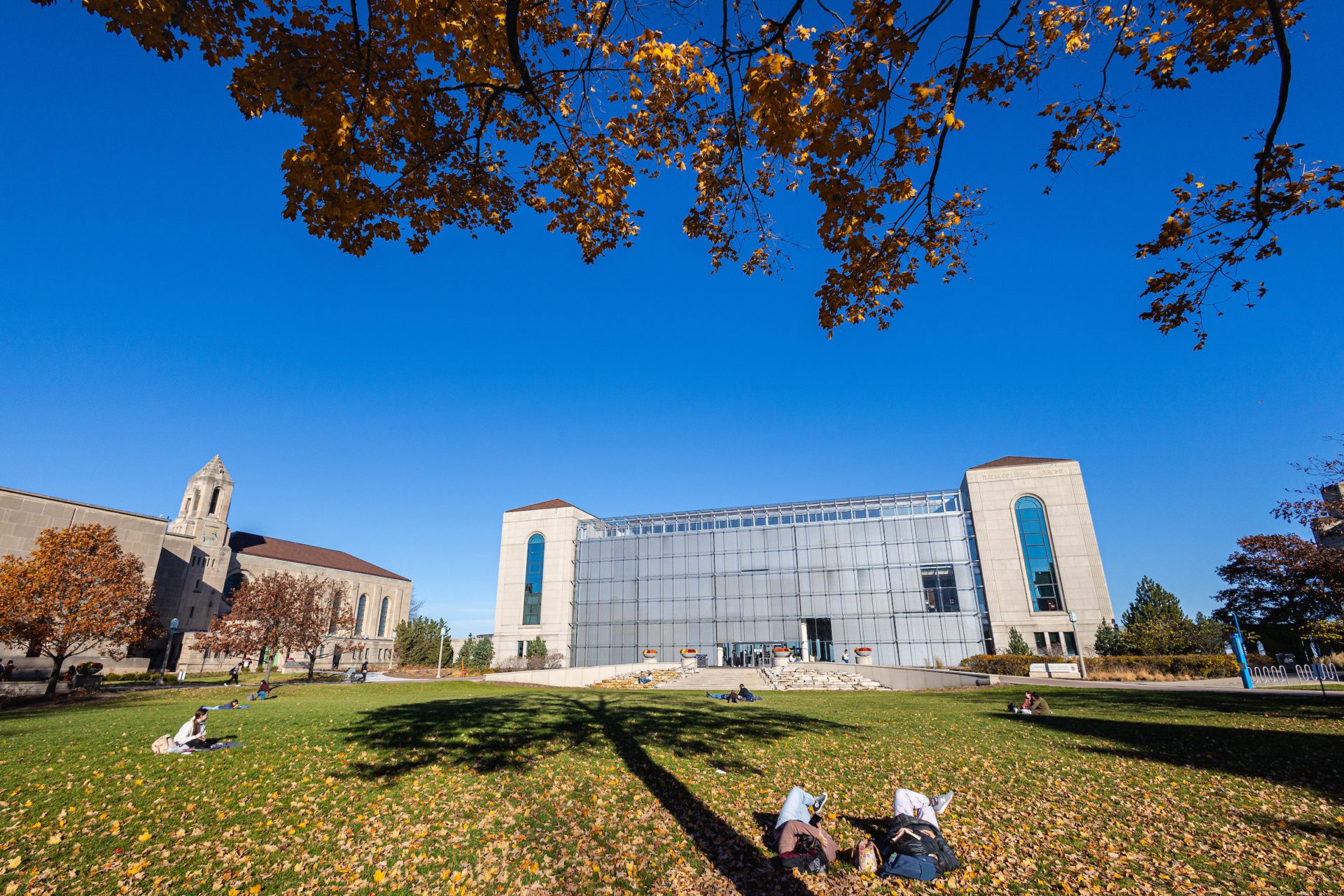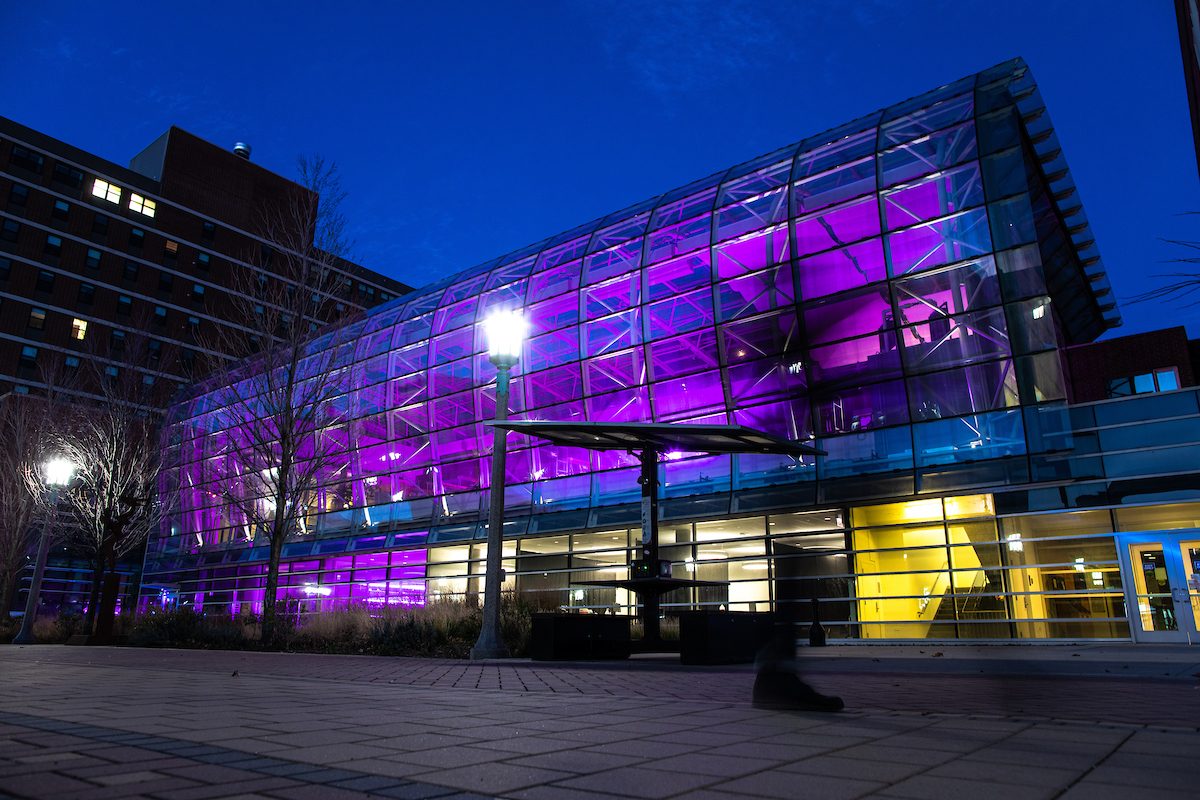Loyola’s commitment to sustainability is nothing new

The previous night, tornado sirens had wailed for over an hour, preceding the arrival of a violent storm. By noon the following afternoon, the heat index on Loyola University Chicago’s Lake Shore Campus had spiked to a suffocating 105 degrees. It was Chicago’s first blast of contemporary summer, and a fitting moment to discuss the University’s comprehensive response to the planet’s environmental crisis.
Summarizing all that Loyola has done on the sustainability front in the 21st century is a tall order; a commitment to the planet’s health has become a lodestar for University leadership, influencing decisions massive and marginal. But it’s seen most clearly in Loyola’s infrastructure, one of the greenest in higher education.
Our guide is Kana Henning, Loyola’s senior associate vice president for facilities. Roughly 80 percent of Loyola’s carbon footprint is derived from the performance of its buildings, which Henning—who joined the Facilities Department in 2005—now oversees. We scuttle plans for a stroll, ducking instead into the cooler confines of a Sherry Hall conference room, its wallpaper inspired by campus architectural blueprints.
Inside, Henning reminisces. In the early 2000s, her old boss, Phil Kosiba, came to the obvious conclusion that Loyola’s buildings were both inefficient and ill-equipped to handle the severity of Chicago’s increasingly extreme weather. The University’s first major energy audit of the Lake Shore Campus, taken in 2001, underscored those concerns. Maintenance had been deferred too long. Green technology was emerging. If Loyola wanted to stop hemorrhaging resources (both financial and natural), the University needed to reimagine how its grounds looked and operated.
What followed? Capital planning and investments that boldly prioritized the environment. And the University’s Board of Trustees drew a marker in the sand: in adopting a Climate Action Plan, Loyola would be carbon neutral for directly controlled emissions by 2025. (That includes on-campus emissions as well as off-campus emissions—like purchased electricity—that are nonetheless directly linked to Loyola.) To get there would require the demolition or redevelopment of aging systems, along with a ridiculous amount of adaptation. In other words: time, money, and expertise.
“There was definitely a learning curve for everyone involved,” says Henning. “We were being pushed by our design team to embrace building technology and design features that were completely foreign to us.”
For Henning, the construction of the Information Commons (IC), in the mid-2000s, proved instructive. Architects aspired to create an all-glass building along the Lake Michigan shoreline. What they didn’t want Loyola to do was owe utility providers massive bills every month. And so Loyola representatives flew to Stuttgart, Germany, where they met climate engineers already grappling with these thorny design questions. Many Germanic innovations made their way back into the IC: a double-skin facade (Chicago’s first); mechanically operable blinds; a green roof; and an array of sensors that monitor the building’s temperature, humidity, and carbon dioxide levels. What shocked Henning at the time was just how comfortable these state-of-the-art buildings could feel. “That was the ah-ha moment for me, personally,” she says now.
“After the IC, we could never build a traditional building ever again.”
And they really haven’t. Today, Loyola boasts 13 LEED Silver or Gold rating buildings and an ambitious energy management portfolio. The School of Environmental Sustainability building has a geothermal system with 91 wells stretching 500 feet into the ground. Cuneo Hall adds a net-zero ready building to the University’s historic quad. The Damen Student Center has an earth duct in which air is pre-tempered underground. Everywhere you turn, there’s permeable paving or rain gardens or stormwater treatment systems. The list stretches on. And despite all the physical expansion, per-capita energy use on campus has been more than halved since 2008.

“We get so much pride in seeing these buildings come to life,” Henning says. “And then we come back and observe and test, making sure we’re really getting the performance out of them that we need.”
Aaron Durnbaugh tracks that performance closely, too. A decade ago, Durnbaugh founded Loyola’s Office of Sustainability, which he describes as the University’s internal consultant on all things green. Before he came to Loyola, Durnbaugh worked for the City of Chicago as a deputy commissioner for natural resources and water quality. “I was really interested in spending time at one institution and developing programs over time,” he says, “going from a mile wide and an inch deep to an inch wide and a mile deep.”
Among an assortment of responsibilities, his shop runs waste programs, performs greenhouse gas inventories, and serves as a resource for anyone on campus interested in building innovation and efficiency into the University’s programs. (Durnbaugh also produced Loyola’s Climate Action Plan, back in 2015.) These efforts are all anchored in social justice—a warming planet impacts everyone and everything, but vulnerable people bear the burden disproportionally.
When it comes to Loyola’s carbon neutrality goal, Durnbaugh says Loyola is “still grinding away,” getting closer and closer each day. The last few percentage points are typically the hardest to shave off. He and Hennig are also looking forward, trying to understand what big-picture tasks they should be planning to tackle. Renewable energy procurements. The electrification of transportation. Decarbonization. Climate adaptation and resilience.
All of this work is justifiable, fiscally and morally. Demonstrating a commitment to the planet can help support student recruitment and retention, too. One recent admissions survey found that over half of incoming freshmen describe Loyola’s sustainability efforts as “important” or “very important.” Young people are understandably worried about the future—it’s the world they’ll inherit. Why not try to save it?
“Students are very invested in these questions,” Henning says. “If they get an inkling or a whiff that, for some reason, our actions aren’t aligned with our values, they will call us on it. They continue to push us.”
Read more stories from the School of Environmental Sustainability.


